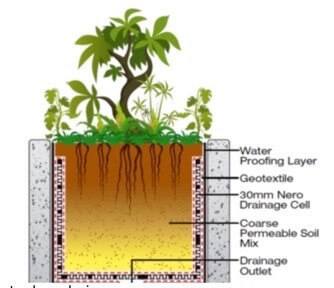There is a growing trend in modern architecture that attempts to marry nature with construction. This seems a very easy and simple idea, but it is in fact very complex.
You see, at the very heart of construction has long been a desire for that construction to be the opposite of nature. That is, it must be able to stand up against nature, resisting water and wind and heat and cold. It must look and feel very much not like nature at all. It must resist.
So the move to marry the two has not been a natural fit. But it is happening.
In order to do this, architects must be prepared to deal with water, the enemy of buildings.
One way this happens is with planter drains.
Planter drains keep dirt in and let water out
In a perfect world, you would put exactly the right amount of water on your plant every time, and that would be the end of that. However, the world is not perfect. Sometimes you under-water. Sometimes you over-water. In fact, usually you over-water.
This is true in nature too. When the skies open, they usually deliver more water than the dirt can handle right in that moment, so the water must be taken away and re-enter the water cycle.
This is where a planter drain comes in handy.
Beneath the plants, beneath the soil, are one or more finely knit meshes that allow water to soak out without taking the dirt with it.
Additionally, at the top of the planter, is a metal tube with holes in it to quickly drain water that overflows and floats even above the soil line.
These together constitute a planter drain.

Picture is a screenshot from rainsmartplanters.com
The goal is to work together to quickly shunt water away from the soil, not allowing any of it to stand. However, the mesh is in place to prevent the soil going with it.
Many municipalities are experimenting with stormwater planters to help reduce runoff. A key piece of every one of these stormwater planters are planter drains, which allow water to be trapped in soil that feeds a series of plants that are beautiful, hearty, and which absorb a lot of water.
